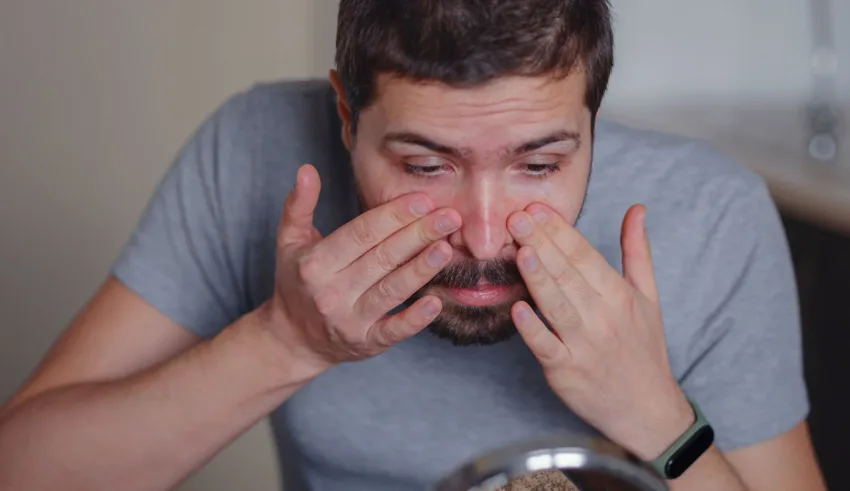
Acne affects just about everyone at some point in their lives, sometimes at the most inconvenient time. The good news is that there are better treatment options today, such as medications and topical products. The downside? You may be left with scars. However, there are ways to minimize the appearance of those scars. In this article from The Dermo Lab and in collaboration with Dr. Rania Al Sheikh, we’ll shed light on the different types of acne scars and the treatments available.
What are the different types of acne scars on the face?
Here’s an overview of the different types of scars that acne can create:
Dr. Rania Al Sheikh classifies acne scars into 2 categories: atrophic acne scars and hypertrophic and keloid scars.
- Atrophic acne scars
The following three types of scars are called “atrophic” because they are depressions in the skin, as opposed to scars raised up from the skin.
- Ice pick acne scars
Dr. Rania Al Sheikh explains that ice pick scars are usually deep, narrow indentations that are common on the cheeks. They can look like a scar made from a tiny ice pick. This is one of the most difficult scars to treat.
- Boxcar acne scars
Boxcar scars are not as narrow as ice pick scars. Dr. Rania Al Sheikh notes that they are usually a wider depression in the skin, with edges that may be more defined. They can look like a chicken pox scar. Wider scars can be more difficult to treat than narrower scars.
- Rolling acne scars
Dr. Rania Al Sheikh says that rolled scars are often the widest of the atrophic scars and may not have distinct edges. Instead, they will likely have varying depths, curved edges, and a more irregular appearance.
- Hypertrophic and keloid scars
According to Dr. Rania Al Sheikh, hypertrophic scars are raised up from the skin due to excessive collagen production during healing. They are less common than the others and are mainly associated with body acne.
Who can get acne scars?
Some people are more likely to develop scars when their acne clears. The risk increases when a person:
- Has inflammatory acne (swollen, red, and painful)
This often includes acne cysts and nodules. This type of acne tends to penetrate deep into the skin and damage it.
- Delays or does not treat inflammatory acne
The more prolonged inflammatory acne lasts, the higher the risk of scarring.
- Prick, squeeze, or pop acne
This increases inflammation, which increases the risk of scarring.
- Has a blood relative who has developed acne scars
Genes play an important role.
Although we know what increases the risk of acne scars, it is not possible to predict who will develop acne scars. Even people who have all the risk factors may not develop scars.
However, it is possible to prevent acne scars with effective acne treatment. Waiting to treat acne until it becomes severe can lead to significant scarring.
What is the treatment for acne scars?
Treatment options for atrophic acne scars
Treatment for this type of scarring typically involves reducing the depth of the scar and then treating any discoloration. Treatments include:
- Chemical peels. Used to remove the top layers of skin and encourage the growth of new skin in cases of mild scarring.
- Laser resurfacing. Uses lasers to treat the layers of skin and encourage new skin growth.
- Dermabrasion. Removes the top layer of skin to encourage the growth of a smoother layer in its place.
- Dermal fillers. Substances such as hyaluronic acid can be injected to fill the scar temporarily.
- Microneedling. Tiny needles are used to encourage collagen production and reduce scar depth.
- Punch excision. The scar is cut out and then stitched back together to create a less visible scar.
- Punch grafting. The scar is cut away and replaced with skin taken from elsewhere, usually behind the ear.
- Subcision. The scar tissue is detached from the skin so that it can be lifted and appear less visible.
- TCA CROSS peels. Trichloroacetic acid (TCA) is used on a scar to encourage collagen growth.
Treatment options for hypertrophic acne scars
Treatment for hypertrophic scars involves reducing the height of the scar. Treatments include:
- Laser resurfacing
- Steroid injections to soften the scar tissue and reduce its size
- Surgical removal
Frequently asked questions
Are acne scars permanent?
They can be. Most acne scars do not go away on their own. However, professional treatments can help heal scars or minimize their appearance. Over-the-counter remedies can help improve the appearance of small blemishes, but they do not treat severe acne scars. According to Dr. Rania Al Sheikh, hypertrophic and ice pick scars are permanent scars.
Do acne scars get worse with age?
Not all acne scars are permanent. However, with age, some scars that leave depressions in the skin (such as boxcar scars) seem to get worse because your skin becomes less firm overall.
What are the most common acne scars?
According to Dr. Rania Al Sheikh, atrophic types are the most common acne scars.Ice pick scars account for about 60% of them, boxcar type scars account for at least 20% of them, and rolling scars account for the rest.
A word from The Dermo Lab
Everyone experiences acne from time to time, and sometimes acne causes scarring as it heals. Acne scars vary in appearance depending on the type and severity of the acne. Even with the most careful treatment, you can develop acne scars.
There are many treatments for acne scars of all types. If you are concerned about acne scars, consult your dermatologist to develop a treatment plan that is right for you.
Last Updated on April 16, 2024








